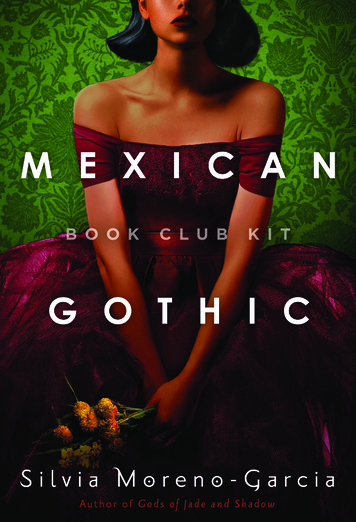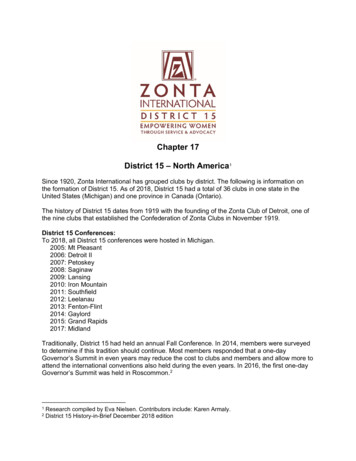
Transcription
B O O KC L U BK I T
A LETTER FROM THE AUTHORDear Readers,Mexico is peppered with mining ghost towns. The description has a double meaning.On the one hand it refers to an abandoned place. On the other hand, these towns carrywith them the traces of colonial rule and all its excesses. They are filled with ghosts.When the Spaniards arrived in Mexico, they found a trove of mineral riches: gold andespecially silver that could be mined in huge quantities. By the 18th century, Mexicowas the world’s chief silver producer.Bustling mines required workers, and cheap ones. The predominant laborers in thesetowns were Indigenous people who were forced to work the mines through severalsystems—slavery, enconmienda and repartimiento were used at different points intime—and often abused, toiling in bad conditions. Those who did not labor in themines might still feel the brunt of Spanish rule, by being driven from their traditionallands.The War of Independence of 1810 did not really ease the grasp of foreign powerson Mexico and its riches, nor did it distribute those riches more evenly. After theSpaniards, there came other powers to pry the earth for silver.British mining companies arrived in the early 1800s and established themselvesthroughout the country, including in the town of Real del Monte, high in the mountainsof Hidalgo. Nicknamed ‘Little Cornwall,’ Real del Monte boasts a unique British-inspiredarchitecture and an English Cemetery out of a Hammer film. It is this town, which Ivisited many years ago, that serves as the basis for the location of Mexican Gothic.It might sound a bit odd for a book titled Mexican Gothic to actually take place in atown that was modeled and exploited by British forces. Yet that is part of the ironiclegacy of Latin America. I suppose I could have called the book Postcolonial Gothic,but that seems so much longer and less zesty. Mexican Gothic expresses the hauntingfeeling I had when we drove through Mexico looking at the remains of towns fromanother era.To know a place, you must look at the land. What the land told me in Hidalgo is thatthere are ghosts and then there are ghosts. The ones that wear bed sheets over theirheads are much less terrifying than the ones left by the sins ofour ancestors.Mexican Gothic is a fun romp through a trove of Gothictropes, including a dark and gloomy house, an alluringyet dangerous man, a family with secrets, and thingsthat go bump in the night. But it’s also a story aboutthose other ghosts: the ones that were left like ascar on the land.Silvia Moreno-GarciaPhoto: Martin Dee
DISCUSSION1.QUESTIONS H ow did you feel about the historical period and settingthe book takes place in?2. What did you think of the main character, Noemi?3. Who was your favorite character and why?4.5.6.7.8.9. How did you feel about the relationship between Noemiand Francis? What did you think about the ending? What do you wishhad been different? What do you think the author’s purpose was in writingthis book? How well do you think she got it across? What did you enjoy most about this book? What did youenjoy the least? What changes to the story, if any, wouldyou make? Would you read a sequel to this story? Would you prefer itfeature Noemi and Francis, or would you prefer a story inthe same world with new characters? If you were interviewing the author, what questions wouldyou have for her?
THEPLAYLISTThis playlist, curated by the author,will transport you to the terrifyingyet seductive world of High Place.Listen on Spotify athttps://spoti.fi/2yHyItz1.2.3.“Black Walls” by Chromatics“ Eyes Without a Face” byMarsheux“ Girls Just Wanna Have Some”by Chromatics4.“ The Killing Moon” by Echo &the Bunnymen5.“ Is Your Love Strong Enough?”by Bryan Ferry6.7.8.9.“ Digital Versicolor” by GlassCandy“ Shadow” by Chromatics“ Passion of Lovers” by Bauhaus“ Wicked Game” by UrsineVulpine, Annaca10. “ Blue Wings” by Wild Nothing11. “ Shadowplay” by Joy Division12. “ Cat People (Putting Out Fire)”by Martyn Lenoble,Christian Eigner13.14.15.“Goodbye Horses” by Psyche“TOY” by Chromatics“ Journal of Ardency” by ClassActress16.“ Tainted Love” by MarilynManson17.“ She’s Gone Away” by Nine InchNails18. “ Bonbon (Johnny Jewel Remix)”by Lou Rebecca, Johnny Jewel19. “ Tell Me Where It Hurts” byGarbage20.“ Tear You Apart” byShe Wants Revenge21. “ She’s Lost Control” byJoy Division22.“Saturday” by Desire
THEREAL DEL MONTEby silvia moreno-garciaOne time I was asked during an interview whether it really rained inMexico City as much as I said it did in one of my novels. It does rain andin fact parts of the city might flood periodically. When people think ofMexico, they tend to picture tumbleweeds and deserts. My interviewer,having little grasp of the varied features of the country, was one of those folks whopictured the whole nation as one hot desert, out of a Speedy Gonzales cartoon.My upcoming novel, Mexican Gothic, takes place in a chilly, fog-shrouded town atthe top of a mountain, a town with a deep British influence. For some people, sucha locale would seem incompatible with their idea of Mexico. But Mexican Gothic isinspired by a real town, complete with an English cemetery: Real del Monte.Real del Monte, also called Mineral del Monte, is located in the mountains ofHidalgo. Humboldt called this region the Mexican Andes due to its mountainchains that cross each other, forming a series of steep peaks. The territory isuneven, puckered by deep ravines, and the valleys at the feet of the mountainshave fertile soils. The predominant rocks in the region include basalts, vestigesof huge lava currents. The Basaltic Prisms of Santa María Regla, a series of tall,polygonal columns of basalt rock with twin waterfalls streaming down the rocks,are some of the most amazing examples of such rock formations.Obsidian is abundant in Hidalgo. The prehispanic people of the region mined theSierra de las Navajas for this volcanic glass which was used in weapon making. It’salso a region rich in silver.After the Spanish conquered Mexico, they quickly began exploiting its silverdeposits. When Humboldt visited Guanajuato, one single mine there, the Valenciana,was the source of one fifth of all the silver production in the world. One reason theSpanish were able to make such huge profits on silver was the fact they had accessto cheap labor in the form of the Indigenous people of the area. Through outrightslavery or various forms of forced labor, they mined the rich silver deposits of thecountry until the War of Independence broke out.Towards the second half of the 19th century, mining companies from other partsof the world began to make themselves at home in Mexico. That’s when the Britisharrived in Real del Monte, earning the area the nickname Little Cornwall. You canclearly see their influence in the architecture of the town: the sloping roofs area dead giveaway. It’s also obvious in its English Cemetery, which, thanks to itsvariety of trees and the cold of the mountainside, looks like something out of aHammer horror film if you visit it at certain times of the day when the mist clingsto the tombstones, which are all oriented towards England (minus one).
THEDOYLE FAMILY SEAL“Noemí stood up, and as she did she noticed that there wasa mosaic on the floor. Stepping back and looking around the roomshe realized it circled the table. It was another of the snake symbols.The ouroboros slowly devouring itself. The infinite, above us,and below, as Virgil had said.”Illustration: Sara Bardi
THEGIRL IN THE MANSIONHow Gothic Romances Became Domestic NoirsWhatever happened to that girl? You know the one I mean: long hair, old-fashioned dress,with a dark, looming house in the distance and a look of anxiety on her face. She’s mostoften running from said dark house.The girl from the Gothic novels.I’m talking about the mid-20th century Gothic novels, not the original crop of Gothicbooks, like The Castle of Otranto or The Mysteries of Udolpho. No, it’s that second wave ofGothics—termed Gothic romances—that were released in the 1960s in paperback formthat I’m referring to. This was a category dominated by authors such as Victoria Holtand Phyllis A. Whitney, and their covers fixed in the minds of a couple of generationswhat ‘Gothic’ meant.Most of these mid-century gothics tended to adhere to a simple formula which contained a young woman, a big house and a dangerous yet exciting man. Often the womenwere in subservient positions, working for the lord of the manor, orphaned, or the like.The women encountered some mystery that needed solving and eventually found lovewith the dangerous-exciting man, who turned out to be misunderstood (rarely was hea criminal). Although the mystery and threats surrounding the heroine seemed to be ofsupernatural origin, there was usually a rational explanation.As Joanna Russ explains in her essay “Somebody’s Trying to Kill Me and I Think It’sMy Husband: The Modern Gothic,” the 1960s Gothic romance ultimately resembled acrossbreed between Jane Eyre and Rebecca, and publishers such as Terry Carr believedthe appeal of the books was that they featured “women who marry guys and then beginto discover their husbands are strangers . . . so there’s a simultaneous attraction/repulsion, love/fear going on.”Whatever the plot variation, Gothic novels allowed for excitement, romance andsublimated sexual desire, as well as providing the heroine with a certain level of agency:after all, she had to survive and solve the mystery, even if the killer was inside the housewith her.This game of literary Scooby Doo was profitable. Such was the demand for Gothicbooks that in true pulp fashion sometimes one title would be re-issued with a differentcover and a new name.Yet, by the end of the 1970s the Gothic novel seemed to vanish from shelves. Whathappened? Tastes changed. Fans who had previously turned to these books now lookedfor the emergent, spicier romances such as The Flame and the Flower, and readers moreinclined to chills were about to discover Stephen King and the joys of the 1980s horrorboom.And so the genre died. Or did it? Some writers continued to write Gothic novels,even if these were less common than before—V.C. Andrews was probably the only
THEGIRL IN THE MANSIONheavy-hitter in the 1980s mining this niche with Flowers in the Attic. But I believe thatrather than disappear completely, what happened was that the impulses behind theGothic novel mutated and eventually gave birth to what we call the Domestic Noir.In The Contested Castle: Gothic Novels and the Subversion of Domestic Ideology, KateFerguson Ellis argues that Gothic literature presents the middle-class home as a paradox, a site which should feel safe but instead turns horrific. Julia Crouch has definedDomestic Noir as a genre which “takes place primarily in homes and workplaces, concerns itself largely (but not exclusively) with the female experience, is based aroundrelationships and takes as its base a broadly feminist view that the domestic sphere isa challenging and sometimes dangerous prospect for its inhabitants.”Domestic noirs emphasize the female experience with their covers and titles. Perusethe shelves and you’ll find that it’s a world of girls (Gone Girl, The Girl Before), wives(The Wife Between Us, The Silent Wife, My Husband’s Wife, The Perfect Wife), and thelike. The covers of Gothic romances, with their ever-present women and manor, also hita similar beat. No, the titles were not The Wife in the Tower—though I supposed thatmight have been a good choice—but the illustrations, promotional copy and even thechoice of author’s names worked together to give the impression of a female space.In The Gothic Romance Wave: A Critical History of the Mass Market Novels, 1960-1993,Lori A. Paige states that although Gothic romances offered upright heroines, “below thesurface of every story remained an undercurrent of self-conscious repression, vice andeven depravity.” The same could be said of domestic noirs such as The Girl on the Trainwhere a heroine attempts to conceal her alcoholism and the woman she is fascinatedwith—a seemingly perfect woman—is involved in a torrid affair. The Couple Next Doorare obviously hiding a secret; the doting husband of Before I Go to Sleep is not whohe seems; and The Woman in the Window spies on her neighbours, the perfect family,which is not perfect after all.Terry Carr said women liked reading Gothic romances because they featured “amagnetic suitor or husband who may or not be a lunatic and/or murderer,” a man whomight frighten them and make them anxious. It sounds a bit like riding an emotionalrollercoaster. In Domestic Noirs heroines might still fear their husbands, but they alsoseem to be frightened of a wider variety of people including neighbours, friends andeven employees, the rollercoaster taking them through numerous peaks and valleys ofanxiety.Unlike the Gothic romances, though, domestic noirs tend to be firmly rooted in thepresent and the urban—or suburban—experience. In that sense, they are realistic whileGothic romance sought an air of unreality thanks to their great big castles, misty landscapes and old-fashioned settings.I don’t think it’s a perfect straight line between the Gothic romances of old and thecurrent boom of domestic noir, but they both reflect that eerie feeling that the call iscoming from inside the house. And perhaps the phone has been ringing for a long time.
DRESSUP NOEMÍBring Noemí Taboada’s signature fashionto life with this paper doll!Print out the following pages to switch between her many styles, andlearn more about the history behind each of these classic 1950s looks.INSTRUCTIONS:Print and cut out each outfitalong its border. For best results,use cardstock or heavy paper.To construct the stand, cutalong the small black lines atthe base of the model. Slipeach end of the horizontalstrip between the shallowcuts, letting the striparch around the backof the doll to create asupported base.Affix outfits to modelby folding overwhite tabs, andunfolding toremove.
Noemí“She was vain, yes. Thoughshe didn’t think it was a sin.Noemí looked a bit like KatyJurado when she struck theright pose, and of course sheknew what exact pose andangle to strike.”bkNoemí says that she looks abit like classic Mexican filmactress Katy Jurado: shehas that 1950s ideal hourglass figure down pat.She dresses to the nines.Think Liz Taylor inA Place in the Sun, orAudrey Hepburn. Herfavorite designer isprobably Christian Dioror Jacques Fath.
Ballgown“She wore a green gown withwhite appliqué flowers anddidn’t bother to tell her dateabout the switch.”bkNoemí Taboada is a wealthysocialite in 1950s Mexico.This means she owns avariety of ball gowns withdramatic colors and fabrics.This dress evokes thebustle of 19th centurydresses, but has astreamlined silhouette andutilizes modern materialssuch as nylon.
Suit with Calotte Hat“She looked at it curiously asshe adjusted her teal calotte hatwith the long yellow feather andpeered onto the street looking ather ride.”bkFor daywear, a woman in the1950s could opt for severaloptions. A day dress was one ofthem. A form-fitting suit wouldhave been another. Glovesand a hat would complete theensemble.At the beginning of the novel,Noemí is wearing a calotte hat,which is a small hat that closelyhugs the scalp. It would havebeen decorated with feathers,pearls or other materials. Laterin the 1950s, hats grew biggerand wider.
Kickpleat Skirt & Fitted Sweater“She dressed in a long-sleeved buttondown blouse in pale cream and anavy skirt with a kickpleat, put on apair of flats, and headed downstairslong before the predetermined hour.”bkWe associate the 1950s with thepoodle skirt, but at the beginningof the decade, skirts would havebeen less voluminous. Still, theskirt in this daywear ensembleflares out a little and the waist isaccented with a large belt to makeit look tinier and emphasize thehourglass figure. It’s a more “casual”look that also incorporates anotherbig 1950s trend: the fitted sweater.
Nightgown with Peignoir“She was in her nightgown. It wassupposed to be part of a gownpeignoir set, but she was notwearing the cover-up with the wideaquamarine sash at her waist.”bkA wealthy woman in the 1950swould wear a nightgown trimmedwith delicate materials. A peignoirwould have looked quite glamorousand would have normally come ina set.
It might sound a bit odd for a book titled Mexican Gothic to actually take place in a town that was modeled and exploited by British forces. Yet that is part of the ironic legacy of Latin America. I suppose I could have called the book Postcolonial Gothic, but that seems so much longer and less zesty. Mexican Gothic expresses the haunting











